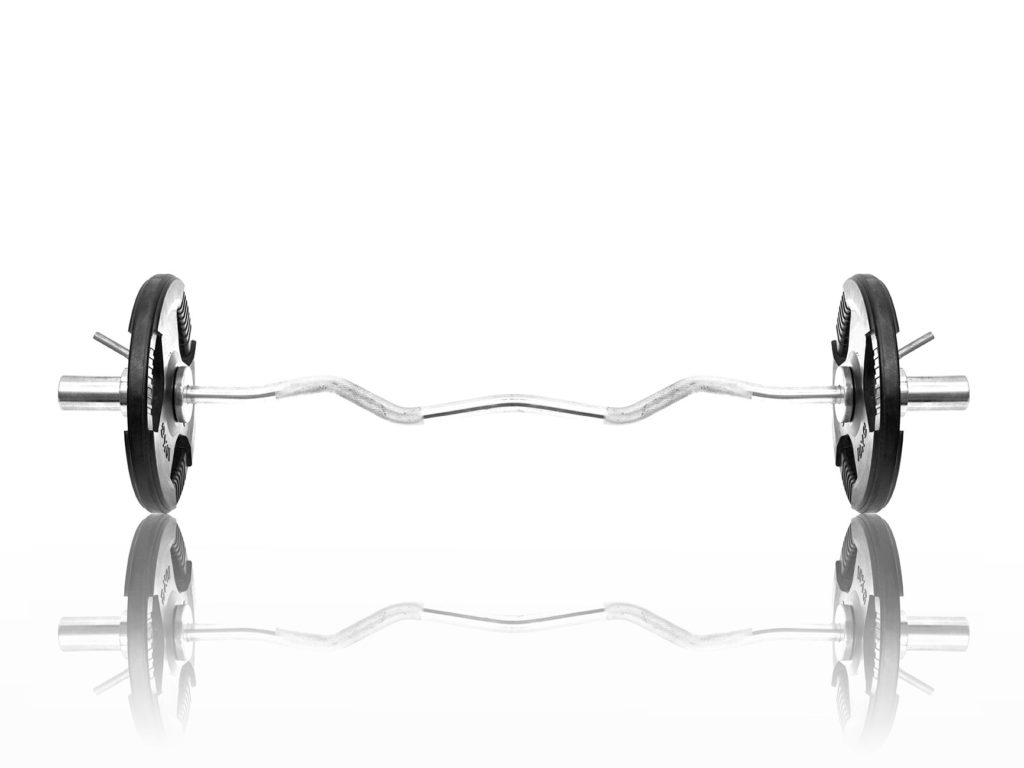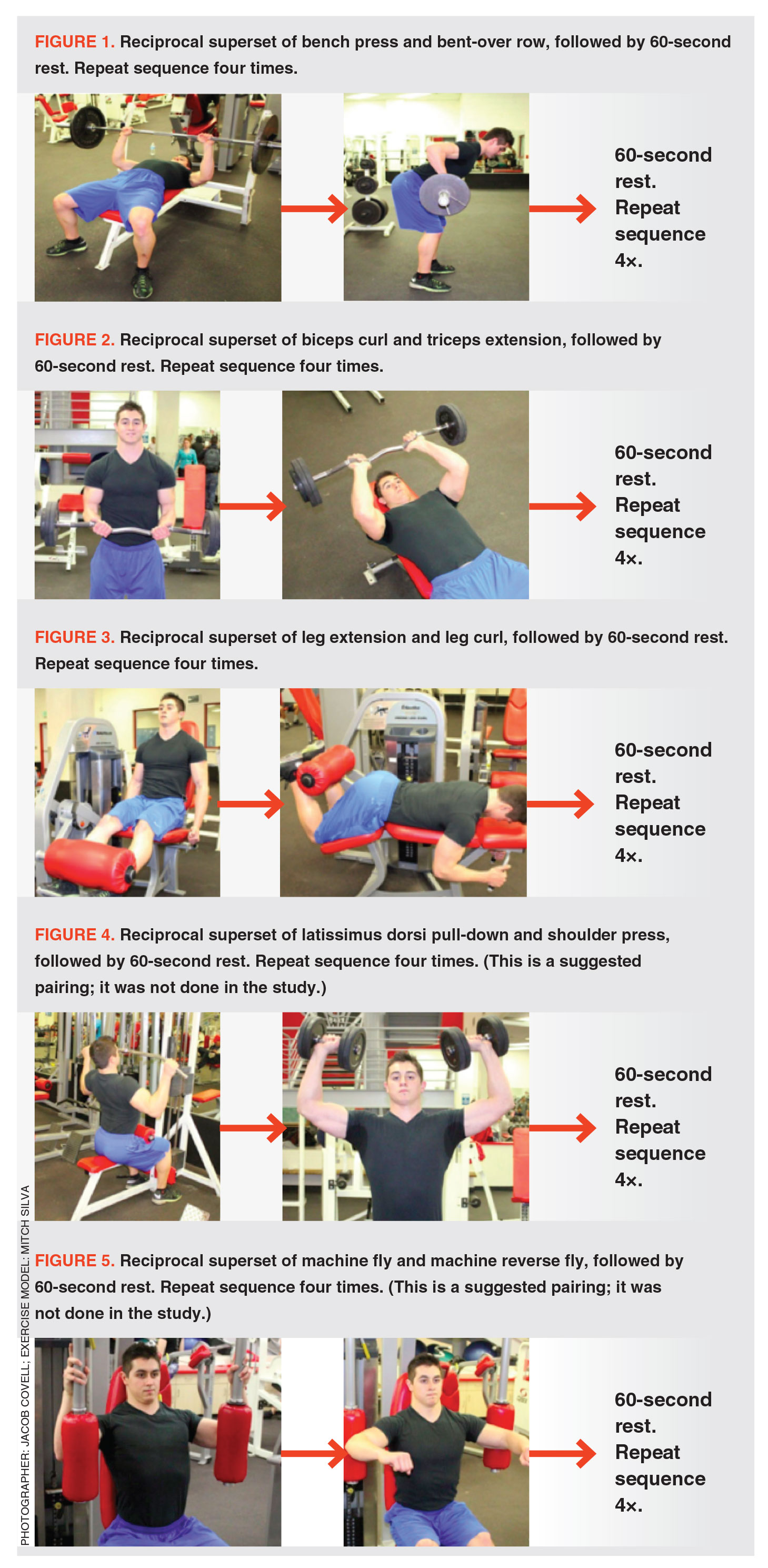
Reciprocal Superset Training Burns More Calories
Kelleher, A.R., et al. 2010. The metabolic costs of reciprocal supersets vs. traditional resistance exercise in young recreationally active adults. The Journal of Strength and Conditioning Research, 24 (4), 1043–51.
Personal trainers pride themselves on developing resistance training programs that help clients improve their musculoskeletal health. Since many clients trying to combat weight gain and obesity are busy people with limited time for exercise, trainers must sometimes rise to the challenge of designing programs that safely consume more calories in shorter time frames.
Of course, no two resistance training programs burn calories at the same rate, making it tough for trainers to decide on the best course for time-starved clients. Kelleher and colleagues confronted this challenge by comparing the calorie consumption of two distinct styles of exercise—traditional resistance training and reciprocal superset training.
Traditional resistance training
involves a set of exercise repetitions to fatigue or near fatigue followed by an appropriate recovery period.
Reciprocal superset training
(also called agonist-antagonist superset training) uses consecutive sets of two exercises targeting opposing muscle groups with a rest only after both sets are completed. For example, a reciprocal superset exerciser might do a set of bench presses and a set of bent-over rows (opposing-action exercises) and then take a rest.
Kelleher and colleagues set out to compare the energy expenditure, excess postexercise oxygen consumption (EPOC, or postexercise calorie burn) and blood lactate response for reciprocal supersets versus traditional weight training. The results suggest that reciprocal supersets offer intriguing possibilities for time-efficient training.
Study Overview
All subjects completed one-repetition maximum testing followed by superset and traditional testing sessions. The two training sessions were separated by a 7-day recovery period, often called a “washout” in research, when participants were encouraged not to do any supplementary exercise. Supersets were always performed in the first of the two training sessions, because pilot testing showed that this type of training was more fatiguing. Thus, superset training established the number of repetitions performed for each exercise.
For this study, exercises, sets, repetitions and repetition speeds were perfectly matched in the two protocols. Only rest periods were different between them.
To help ensure that participants adhered to a similar dietary plan before each training period, they recorded their normal food choices and portion sizes for the meals and snacks eaten in the 2 days before the first (superset) training session. Then, the researchers asked participants to eat the same 2-day diet prior to the traditional testing session. Food choices and portion sizes can influence energy expenditure, which was a main interest variable in this study.
Subjects
Ten men (average age, 22; average weight, 165 pounds/75 kilograms) participated in this study. All were recreationally trained, which the researchers defined as participating in 45–90 minutes of traditional resistance training two to four times a week for 6 months before entering the study. None of the participants had done superset training before.
1-RM Testing
All the men completed 1-RM testing (following nationally established protocols) for the six exercises used in the training protocols. 1-RM testing was performed on the following exercises, in this order: bench press, bent-over row, biceps curl, lying triceps extension, leg extension and leg curl.
This testing allowed the researchers to determine the 70%-of-1-RM training intensity for all exercises. 1-RM testing established the greatest load each participant could lift just once for each exercise; then, in both training sessions, each participant trained at 70% of his 1-RM for every exercise.
Superset Protocol
In each superset, a set of the first exercise was followed immediately by an exercise set for the opposing muscle action. Each exercise set was performed to maximal voluntary muscle fatigue. After each superset, participants rested 60 seconds before beginning the next superset.
The paired exercises in the superset group were bench press with bent-over row, biceps curl with lying triceps extension, and leg extension with leg curl (see Figures 1–3). Participants repeated each superset sequence four times before moving on to the next pair of exercises. All exercises had a 2-second concentric phase and a 2-second eccentric phase.
Traditional Protocol
All 10 men performed traditional sets to voluntary muscular fatigue for each of the six exercises. Participants performed four sets of each exercise with a 60-second rest between sets and then moved on to the next exercise (beginning after a 60-second rest). All exercises had a 2-second concentric phase and a 2-second eccentric phase.
Resting Energy Expenditure Measurement
Resting energy expenditure (REE) was measured before each training session. Participants were reminded to refrain from any resistance training and aerobic exercise prior to each training protocol, to avoid drinking alcohol within 24 hours of training and to refrain from caffeine consumption within 12 hours of training. In addition, the researchers asked subjects not to eat for 5 hours before each training session; those hours fell between 1:30 pm and 7:30 pm on a training day.
Such precautions were taken because these factors influence energy expenditure. Prior to a training session, the men rested for 30 minutes in a supine, calm position, and researchers obtained REE measurements from a 10-minute collection of metabolic gases.
Exercise Energy Expenditure and Blood Lactate
Participants wore a breathing-gas-collection facemask connected to a portable metabolic analyzer strapped to their bodies during and after the workout. This equipment measured exercise energy expenditure and EPOC (the increase of energy expenditure, above preexercise levels, following exercise). EPOC measurements lasted for 60 minutes after exercises ended. Blood lactate levels were also measured during and after the workout.
Results
Energy expenditures during the workouts, when expressed relative to the workout time (supersets = 30 minutes; traditional = 36 minutes), were significantly greater for supersets (8.1 kilocalories/minute) than for traditional (6.2 kcal/minute) exercises.
EPOC energy expenditure was 33% higher for supersets than it was for traditional resistance training in the 60 minutes EPOC was measured after exercises were completed.
Peak and average blood lactate levels during the exercise protocols were significantly greater in the supersets than in the traditional exercises. Blood lactate levels are an excellent predictor of overall exercise intensity. The higher blood lactate level concentrations in the supersets were likely due to an increase in anaerobic metabolic demands from doing consecutive exercise sets with no recovery between paired exercises.
Practical Application
Since this was an acute study, it did not compare the chronic (that is, long-term) adaptations for total weight loss, fat loss or changes in muscular strength and endurance of supersets versus traditional training. Thus, it would be beneficial to investigate the protocols of this study in 4- to 12-week time frames, as training adaptations would likely differ over time.
The study clearly shows that compared with traditional training, reciprocal supersets require more energy expenditure relative to the time of the workout, produce much higher EPOC and significantly increase lactate responses.
Thus, this study suggests that personal trainers working with clients on restricted exercise timelines would be well-advised to consider using reciprocal supersets (see Figures 4 and 5 for more ideas to use), as they clearly have meaningfully greater metabolic effects for energy expenditure and make higher-intensity demands of participants.
